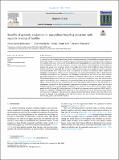Por favor, use este identificador para citar o enlazar a este item:
http://hdl.handle.net/10261/283421COMPARTIR / EXPORTAR:
 SHARE SHARE
 CORE
BASE CORE
BASE
|
|
| Visualizar otros formatos: MARC | Dublin Core | RDF | ORE | MODS | METS | DIDL | DATACITE | |

| Título: | Benefits of genomic evaluation in aquaculture breeding programs with separate rearing of families |
Autor: | García-Ballesteros, Silvia; Fernández, Jesús CSIC ORCID; Toro, M. A.; Villanueva, Beatriz | Palabras clave: | Aquaculture breeding programs Common environmental effect Fish GBLUP |
Fecha de publicación: | 15-oct-2021 | Editor: | Elsevier BV | Citación: | Aquaculture 543: 737004 (2021) | Resumen: | A common type of rearing in aquaculture selective breeding programs is to keep families in separate tanks until fish is large enough to be individually tagged. This type of rearing introduces an environmental effect common to the members of the same family which can be difficult to be disentangled from genetic effects when traditional BLUP evaluation is used. The use of genomic evaluation could lead to a better prediction of these effects as markers can capture more accurately genetic relationships between fish raised in different tanks and between full-sibs raised in the same tank. The objective of this simulation study was to predict the benefit of genomic evaluation (GBLUP) when compared to BLUP in the presence of common environmental effects. Models that included or excluded these effects when they were present were compared. Populations with two different levels of linkage disequilibrium were generated. The heritability of the selected trait was 0.4 and three different proportions of phenotypic variance due to common environmental effect (0.0, 0.1 and 0.3) were considered. Nested mating designs where each male was mated to two females were simulated to create 200 full-sib families with 10 or 50 fish per family. GBLUP was less affected than BLUP by the presence of common environmental effects. The loss in genetic gain ranged from 0% to 4% with GBLUP and from 2% to 7% with BLUP. As a consequence, the benefit of GBLUP increased in the presence of common environmental effects, and the extra benefit increased with increasing linkage disequilibrium and family size. In the absence of these effects, genetic gain from GBLUP was up 20% higher than from BLUP and in their presence, genetic gain from GBLUP was 27% higher than from BLUP. Although GBLUP always led to lower inbreeding than BLUP, there were no extra benefits in terms of extra reductions in the presence of common environmental effects. Finally, when these effects were present but ignored in the evaluation model, the loss in genetic gain was moderate but inbreeding increased dramatically, particularly in BLUP scenarios. | Descripción: | 8 Pág. Departamento de Mejora Genética Animal | Versión del editor: | https://doi.org/10.1016/j.aquaculture.2021.737004 | URI: | http://hdl.handle.net/10261/283421 | DOI: | 10.1016/j.aquaculture.2021.737004 | ISSN: | 0044-8486 |
| Aparece en las colecciones: | (INIA) Artículos |
Ficheros en este ítem:
| Fichero | Descripción | Tamaño | Formato | |
|---|---|---|---|---|
| Benefits-of-genomic-evaluation-in-aquaculture-breeding.pdf | artículo | 1,22 MB | Adobe PDF |  Visualizar/Abrir |
CORE Recommender
SCOPUSTM
Citations
4
checked on 25-abr-2024
WEB OF SCIENCETM
Citations
5
checked on 26-feb-2024
Page view(s)
50
checked on 30-abr-2024
Download(s)
95
checked on 30-abr-2024
Google ScholarTM
Check
Altmetric
Altmetric
NOTA: Los ítems de Digital.CSIC están protegidos por copyright, con todos los derechos reservados, a menos que se indique lo contrario.
